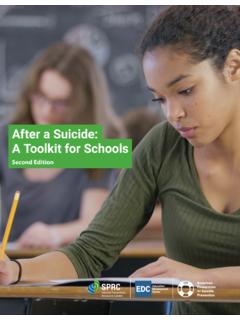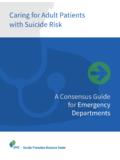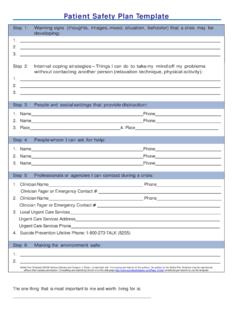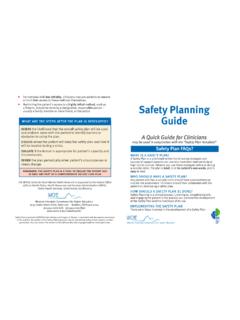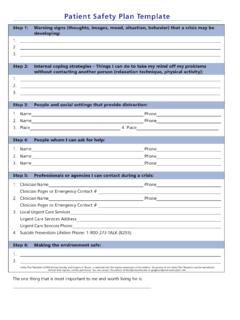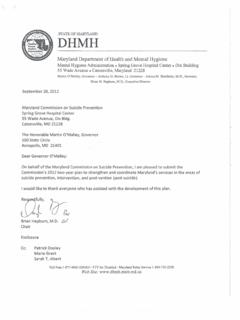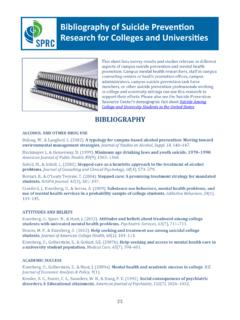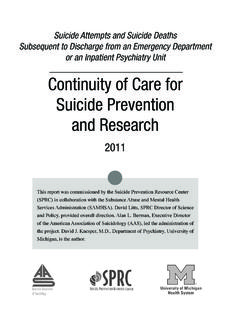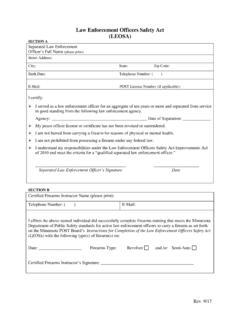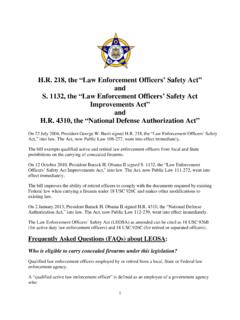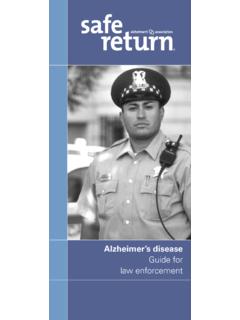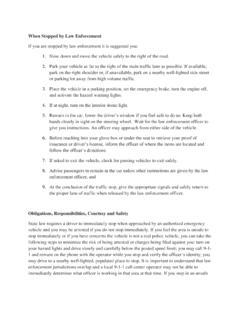Transcription of The Role of Law Enforcement Officers - SPRC
1 | 1 |The Role ofLaw Enforcement Officers in Preventing SuicideJoe and Al, two law Enforcement Officers , were dispatched on a general disturbance call. A neighbor had called 911 saying she heard a loud argument in the house next door, and it sounded like someone might get hurt. Arriving at the scene, the Officers found a husband and wife arguing, but no one was physically hurt. Stephen, the husband, was intoxicated. His wife, Linda, said that he had been out of work for six months, and they were having financial problems. Recently he d also been depressed and lethargic, and kept saying things like I m tired of all this and just want to end it all. Joe asked Stephen if he was thinking of killing himself. Stephen admitted that he had considered taking his life. Joe said that Stephen needed to go to the hospital so that he could be evaluated and get help to deal with his problems. After some hesitation and reluctance, Stephen finally agreed to go. At the hospital, Joe told the emergency department physician that Stephen had become depressed after being unemployed for six months and he had been drinking and had admitted that he considered taking his life.
2 The physician thanked Joe for the information and said it was helpful.(Based on the experiences of a law Enforcement officer )Key Steps to Reduce Suicide Risk among the People You Serve: Understand why suicide prevention fits with your role as a law Enforcement officer Identify people who may be at risk for suicide Respond to people who may be at risk for suicide or have attempted suicide Help suicide loss survivors at the scene Consider becoming involved in suicide prevention in your agency and communityThe purpose of this sheet is to help law Enforcement Officers learn how to identify and respond to people they serve who are suicidal or have attempted suicide. Although the focus is not on suicide among Officers , the Resources section of this sheet contains a number of items addressing that important issue. | 2 |Understand Why Suicide Prevention Fits with Your Role as a Law Enforcement officer Like Joe and Al in the vignette, law Enforcement Officers often deal with situations involving an individual who is suicidal.
3 These include: A person is communicating a desire or an intent to attempt suicide A person has just made a suicide attempt A person has died by suicideIn a significant number of cases, Officers receive a call that is not described as a suicidal crisis, but rather as a general disturbance, domestic violence, or similar type of situation. Upon arriving at the scene, the Officers need to determine whether the situation involves someone who is suicidal. You have an important role to play in all of these situations. It is generally considered to be within the scope of a law Enforcement officer s duty to protect the safety of the community as a whole as well as individuals. Your first responsibility is to deal with any safety issues that may affect you, the person who is suicidal, or others present at the scene, especially if the person has immediate access to lethal means. You can also provide clarity and support to the person who is suicidal and the other people who are there.
4 Then your role, along with that of EMS providers and mental health professionals if they are present, is to ensure the person receives an evaluation as soon as the factsSuicide touches everyone all ages and incomes; all racial, ethnic, and religious groups, and in all parts of the country. Suicide takes the lives of about 38,000 Americans each year (CDC, 2010). About 465,000 people per year are seen in hospital emergency departments for self-injury (CDC, 2010). Each year over 8 million adults think seriously about taking their life, and over 1 million make an attempt (NSDUH, 2011).However, there is help and hope when individuals, communities, and professionals join forces to prevent Ahead of Time Review the protocols and standard operating procedures required by your law Enforcement agency and in your state and local area for responding to a person with suicidal thoughts, a person who has made a suicide attempt, or a death by suicide.| 3 | Learn how you should deal with a suicidal person who refuses to be transported for an evaluation.
5 Meet with your local emergency medical services (EMS) providers to discuss how you can work together to help people who are suicidal, including those who refuse to be transported. If your community has a crisis intervention team (CIT) or if you work closely with mental health providers, meet with them to discuss how to work together most People Who May Be At Risk for SuicideLook for signs of immediate risk for suicideThere are some behaviors that may mean a person is at immediate risk for suicide. These three should prompt you to take action right away: Talking about wanting to die or to kill oneself Looking for a way to kill oneself, such as searching online or obtaining a gun Talking about feeling hopeless or having no reason to liveOther behaviors may also indicate a serious risk, especially if the behavior is new; has increased; and/or seems related to a painful event, loss, or change. Ask if the person has been behaving in any of the following ways: Talking about feeling trapped or in unbearable pain Talking about being a burden to others Increasing the use of alcohol or drugs Acting anxious or agitated; behaving recklessly Sleeping too little or too much Withdrawing or feeling isolated Showing rage or talking about seeking revenge Displaying extreme mood swings(Adapted from National Suicide Prevention Lifeline, [ ])Be alert to problems that increase suicide riskCertain problems may increase a person s risk for suicide.
6 Asking if the person has any of these risk factors can help you assess the current situation more accurately and enable you to provide more complete information to medical staff. Some of the most significant risk factors to ask about are: Prior suicide attempt(s) Alcohol and drug abuse Mood and anxiety disorders, , depression, posttraumatic stress disorder (PTSD) Access to a means to kill oneself, , lethal meansWhat is a Crisis Intervention Team Program?The Crisis Intervention Team (CIT) Program is an innovative partnership between local law Enforcement Officers , community mental health providers, advocates, and consumers of behavioral health services. As part of the program, Officers receive intensive training in responding effectively to people in a mental health crisis, including those who are suicidal. For more information, see the University of Memphis CIT Resource Center at | 4 |Suicide risk is usually greater among people with more than one risk factor.
7 For individuals who are already at risk, a triggering event causing shame or despair may make them more likely to attempt suicide. These events may include relationship problems and breakups; intimate partner violence; problems at work; financial hardships; legal difficulties; and worsening health. Even though most people with risk factors will not attempt suicide, they should be evaluated by a professional. (Adapted from Rodgers, 2011 and SPRC, 2008)Respond to People Who May Be At Risk for Suicide or Have Attempted SuicideArriving at the sceneTake all suicide threats and attempts seriously. Follow the recommendations below as appropriate to the specific situation: 1. Ensure the safety of everyone present. This includes eliminating the person s access to any type of lethal means. Make sure you do this in a way that does not put you or others in danger. Be aware that the person may attempt to force you into a suicide by cop situation where a suicidal person engages in life-threatening behavior toward Officers or other people to provoke Officers to fire at him or her.
8 Also be aware of the danger of a potential murder-suicide, including in domestic violence cases. Try to recognize and de-escalate these types of Assess the person for need of medical treatment. If necessary, call for assistance from EMS providers. Then conduct any life-saving first aid that may be necessary before EMS If you need assistance dealing with the person s mental health issues, call an officer with mental health training, a mental health clinician, or a crisis intervention worker. If no one is available, you can call the National Suicide Prevention Lifeline for following steps should be taken by the professional(s) at the scene with the most relevant training and experience. These might include EMS providers, mental health providers, crisis intervention workers, or law Enforcement Officers with mental health training. In some cases, Officers with no mental health training will need to handle the situation on their Establish rapport with the person.
9 Listen carefully to what the person says, and talk in a calm, accepting, nonconfrontational, and supportive manner. Explain what is happening, that you are there to help, and how you can Assess the person for risk of suicide: oIf it is not clear already, determine whether or not a suicide attempt was made. National Suicide Prevention LifelineThe Lifeline is a 24-hour toll-free phone line for people in suicidal crisis or emotional distress. The phone number is 1 800 273-TALK (8255). For a Lifeline wallet-sized card listing the warning signs of suicide and the toll-free number, go to http://www. | 5 | oEncourage the person to talk about how he or she is feeling. Acknowledge the feelings and do not judge them. oIf the person has not made an attempt, ask several direct questions to determine the person s risk for suicide, such as Are you thinking about ending your life (killing yourself)? and Do you have a plan? Do not be afraid to ask these questions.
10 Asking a person about suicide will not encourage him or her to attempt it. Many people who are suicidal are relieved to find someone they can talk with about how they are really feeling. oAsk whether the person has been behaving in ways, or having any of the problems, described on pages 3 4 that indicate potential suicide risk. 6. Supervise the person constantly. Safety continues to be a top priority. If necessary, set up protective measures so that the person cannot engage in suicidal Arrange for any person who is potentially suicidal to be transported to a local hospital s emergency department or a mental health center for an Collect items such as toxic substances, alcohol, drugs, or medications that might have been taken (even just empty containers). Bring these items to the medical and mental health staff to help them determine the appropriate treatment. If the person refuses to be transported, in most states law Enforcement can issue a 72-hour hold for evaluation.
